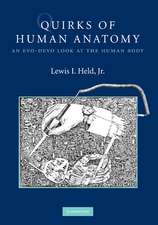Tool Use in Animals: Cognition and Ecology
Editat de Crickette M. Sanz, Josep Call, Christophe Boeschen Limba Engleză Paperback – 5 mar 2014
| Toate formatele și edițiile | Preț | Express |
|---|---|---|
| Paperback (1) | 372.08 lei 6-8 săpt. | |
| Cambridge University Press – 5 mar 2014 | 372.08 lei 6-8 săpt. | |
| Hardback (1) | 553.73 lei 6-8 săpt. | |
| Cambridge University Press – 6 mar 2013 | 553.73 lei 6-8 săpt. |
Preț: 372.08 lei
Nou
Puncte Express: 558
Preț estimativ în valută:
71.21€ • 74.07$ • 58.79£
71.21€ • 74.07$ • 58.79£
Carte tipărită la comandă
Livrare economică 15-29 aprilie
Preluare comenzi: 021 569.72.76
Specificații
ISBN-13: 9781107657434
ISBN-10: 1107657431
Pagini: 324
Ilustrații: 52 b/w illus. 7 tables
Dimensiuni: 170 x 244 x 17 mm
Greutate: 0.52 kg
Editura: Cambridge University Press
Colecția Cambridge University Press
Locul publicării:New York, United States
ISBN-10: 1107657431
Pagini: 324
Ilustrații: 52 b/w illus. 7 tables
Dimensiuni: 170 x 244 x 17 mm
Greutate: 0.52 kg
Editura: Cambridge University Press
Colecția Cambridge University Press
Locul publicării:New York, United States
Cuprins
List of contributors; Part I. Cognition of Tool Use: 1. Three ingredients for becoming a creative tool-user J. Call; 2. Ecology and cognition of tool use in chimpanzees C. Boesch; 3. Chimpanzees plan their tool use R. W. Byrne, C. M. Sanz and D. B. Morgan; Part II. Comparative Cognition: 4. Insight, imagination and invention: tool understanding in a non-tool-using corvid N. Emery; 5. Why is tool use rare in animals? G. Hunt, R. Gray and A. Taylor; 6. Understanding differences in the way human and non-human primates represent tools: the role of teleological-intentional information A. M. Ruiz and L. R. Santos; 7. Why do woodpecker finches use tools? S. Tebbich and I. Teschke; Part III. Ecology and Culture: 8. The social context of chimpanzee tool use C. M. Sanz and D. B. Morgan; 9. Orangutan tool use and the evolution of technology E. J. M. Meulman and C. P. van Schaik; 10. The EthoCebus project: stone tool use by wild capuchin monkeys E. Visalberghi and D. Fragaszy; Part IV. Archaeological Perspectives: 11. From pounding to knapping: how chimpanzees can help us model hominin lithics S. Carvalho, T. Matsuzawa and W. C. McGrew; 12. Early hominin social learning strategies underlying the use and production of bone and stone tools M. Caruana, F. d'Errico and L. Backwell; 13. Perspectives on stone tools and cognition in the early paleolithic record S. P. McPherron; Index.
Recenzii
'Tool Use in Animals: Cognition and Ecology may well be the new benchmark text for animal cognition. This book is clear, well-written, suitably broad in its approach, and delivers information that covers a review of the field in addition to new data. Its appeal will encompass readers from various connected academic disciplines, and [it] is an appropriate text for professionals and for students. This is an important and timely offering, and a happy addition to my library.' Kerrie Lewis Graham, American Journal of Physical Anthropology
'During the half century since Jane Goodall first observed a chimpanzee fashioning and using a tool, there has been great interest and attention to defining, describing, and interpreting tool use among many animal phyla. Whereas some books have catalogued tool use, this volume investigates four behavioral domains - phylogenetic, functional, ontogenetic, and mechanistic … Readers will gain perspective on the interaction of evolutionary and environmental factors shaping tool use behaviour, yet wonder why more animals do not use tools or make better use of them … Highly recommended. Lower-division undergraduates and above; general readers.' J. Burger, Choice
'During the half century since Jane Goodall first observed a chimpanzee fashioning and using a tool, there has been great interest and attention to defining, describing, and interpreting tool use among many animal phyla. Whereas some books have catalogued tool use, this volume investigates four behavioral domains - phylogenetic, functional, ontogenetic, and mechanistic … Readers will gain perspective on the interaction of evolutionary and environmental factors shaping tool use behaviour, yet wonder why more animals do not use tools or make better use of them … Highly recommended. Lower-division undergraduates and above; general readers.' J. Burger, Choice
Descriere
Presentation of groundbreaking research on an extensive range of tool using animals, looking particularly at the evolution of cognitive abilities.











